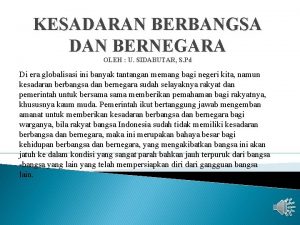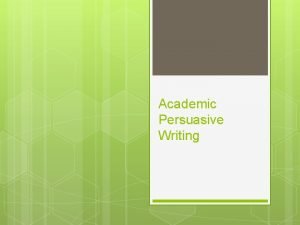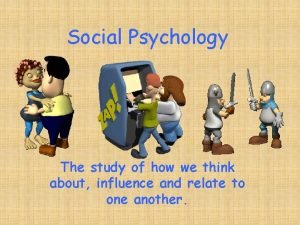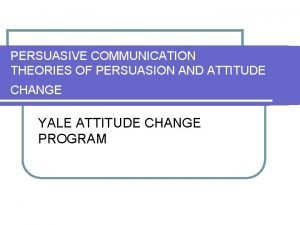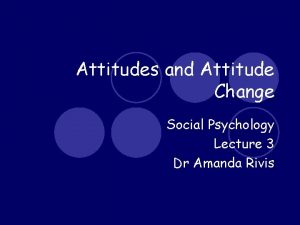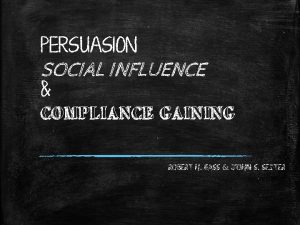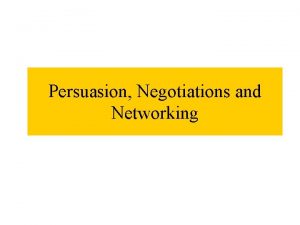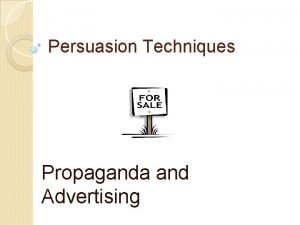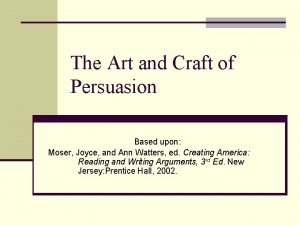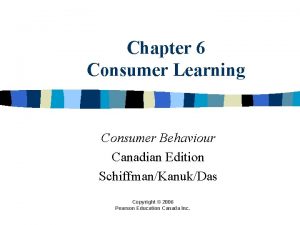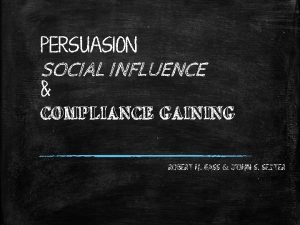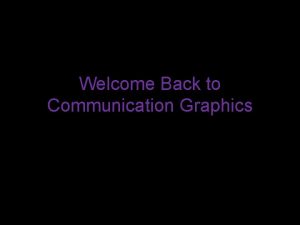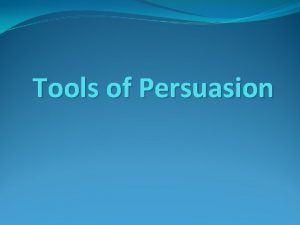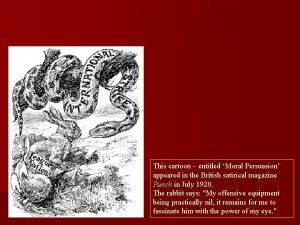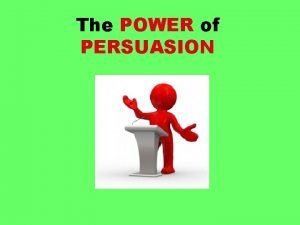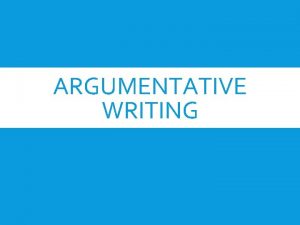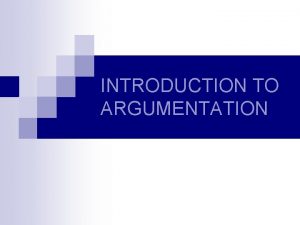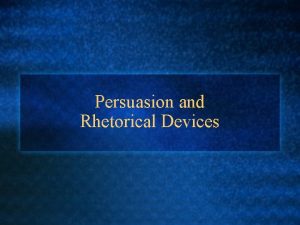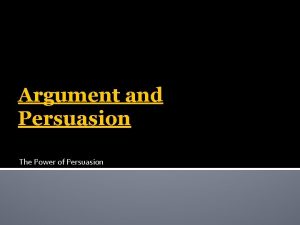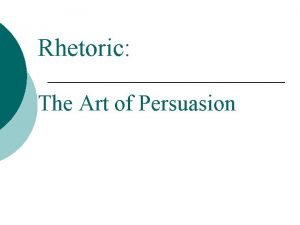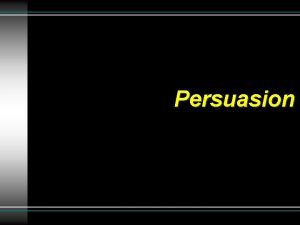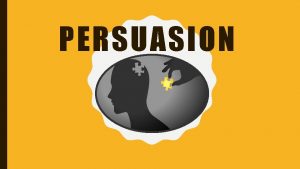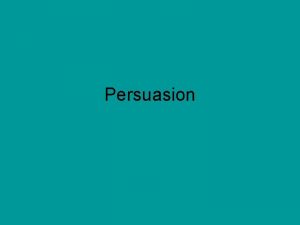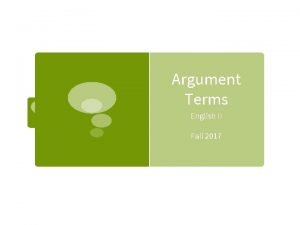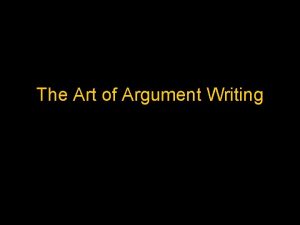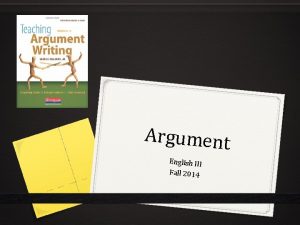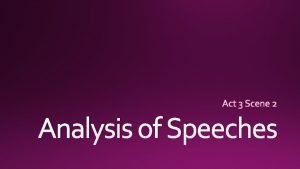Argument and Persuasion RELA 6 What is Persuasion




















- Slides: 20

Argument and Persuasion RELA 6

What is Persuasion? l Persuasion is the art of swaying the thoughts, feelings, and actions of others. l Convincing persuasion appeals to the minds and emotions of others.

What Is an Argument? l An argument is a carefully stated claim supported by reasons and evidence. claim—writer’s position on a problem or issue support—reasons and evidence that help support a claim

Argument Diagram CLAIM Teens Who use the Internet for different kinds of tasks are developing important life skills Support 1: Using the internet for research can help teens become experts at finding information. For example, looking up homework help and comparisonshopping online both require savvy research abilities. Support 1 2 3 Support 2: Teens are learning how to multi-task. One study found that 30% of teens do more than one thing when they are on the Internet—for instance, surf the Web and e-mail friends at the same time. Support 3: The immediate responses required by e-mails and instant messages can help teens learn to type faster and to process information quickly. These abilities are critical in school and business.

The Power of Persuasion l Persuasive techniques, or methods, are used to sway your heart and mind l Caution! Some persuasive techniques can lead to faulty reasoning l Faulty reasoning—claim based on information that is incorrect, biased, or simply does not make sense

Model: Parts of an Argument l Read and examine your copy of the article for a claim and support.

Close Read Questions: Article l l l What is the author’s claim? In your own words, restate two of the supports the author mentions. Look at the boxed text. What examples are given to back up this reason? Does the author include enough evidence to support the claim? Is the evidence for or against the effectiveness of clubs?

Appeals by Association l “Sell” a product or an idea by linking it with something or someone positive or influential

Appeal by Association: Bandwagon l Bandwagon—taps into people’s desire to belong to a group Example: “Don’t miss the fundraiser that everyone’s talking about!” (This works because you don’t want to be the one who is left out. You’ll do what the crowd is doing. )

Appeal by Association: Testimonial l Testimonial—relies on the backing of a celebrity, expert, or a satisfied customer Example: “As the lead singer of Destination Home, I know good sound when I hear it. That’s why I won’t go anywhere without my FX portable music player. ” (This works because you trust the opinion of the speaker. )

Emotional Appeals l Use strong feelings, rather than facts and evidence to persuade.

Emotional: Appeal to Fear l Appeal to Fear—makes people feel as if their safety, security, or health is in danger Example: “If a hurricane hit tomorrow, would your family be safe? ” (This works because we know and fear what hurricanes can do, and we want to protect our loved ones. )

Emotional: Appeal to Vanity l Appeal to Vanity—uses flattery to win people over Example: “We’re looking for talented athletes like you. Join our after-school running club. ” (This works because you’d like to think of yourself in this way. )

Loaded Language l Loaded Language—relies on words with strongly positive or negative associations (connotations) l These words are often called “buzz words” because of the emotional response they create

Loaded Language: Positive Associations l Words with Positive Associations—bring to mind something exciting, comforting, or desirable Example: “Sparkling waters, silky sands, and breezy air all await you at Shongum Lake Park. ” (This works because the description makes it sound like a place you’d enjoy. )

Loaded Language: Negative Associations l Negative Associations —call up unpleasant images, experiences, or feelings Example: “The calves were raised in cramped, filthy stalls. ” (This works because you can imagine what this would be like and feel sorry for the animals. )

Model: Persuasion in Writing l Read and examine your copy of the editorial and ad for persuasive techniques.

Close Read Questions: Editorial l What is the claim in this editorial? l What supporting evidence is provided? l What emotional appeal does the author use? l Look at the boxed examples of loaded language. Find three additional examples.

Close Read Questions: Ad l What claim does this ad make? l What supporting evidence is provided? l Identify the persuasive technique that was used. Why was it used to target teens? l How does the photo enhance the message?

Compare/Contrast Models l Review the editorial and the photo ad. l Compare the viewpoints and the structures used to make claims. What do they have in common? l Contrast them. What differences are there? l Which message is more persuasive? Why?
 Kesadaran berbangsa dan bernegara bangkit pada
Kesadaran berbangsa dan bernegara bangkit pada Sejarah rela
Sejarah rela Ud.rela hati (rh)
Ud.rela hati (rh) Argument vs persuasion
Argument vs persuasion Teleological vs ontological
Teleological vs ontological Central route of persuasion
Central route of persuasion What is the yale attitude change approach
What is the yale attitude change approach Cognitively based attitude
Cognitively based attitude Yale attitude change approach to persuasion
Yale attitude change approach to persuasion Compliance gaining definition
Compliance gaining definition Persuasion and networking
Persuasion and networking Name calling commercial examples
Name calling commercial examples The art and craft of persuasion
The art and craft of persuasion Central and peripheral route to persuasion
Central and peripheral route to persuasion Three hit theory marketing
Three hit theory marketing Robert h gass persuasion download
Robert h gass persuasion download Appeal persuasive technique
Appeal persuasive technique Ranks model of persuasion
Ranks model of persuasion Tools of persuasion
Tools of persuasion League of nations international strife cartoon
League of nations international strife cartoon Elements of argumentative writing
Elements of argumentative writing
